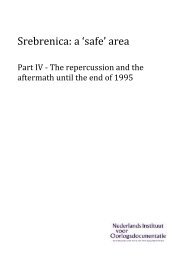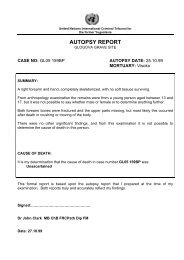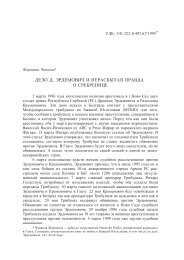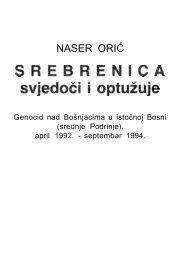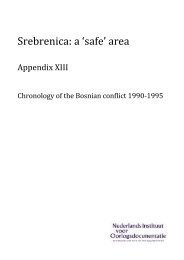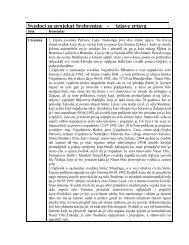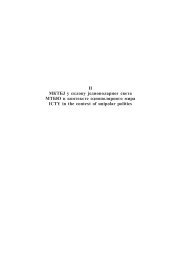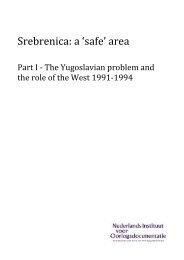0601 Aleksandar Pavic.vp - Srebrenica historical project
0601 Aleksandar Pavic.vp - Srebrenica historical project
0601 Aleksandar Pavic.vp - Srebrenica historical project
Create successful ePaper yourself
Turn your PDF publications into a flip-book with our unique Google optimized e-Paper software.
356 DELATNOST ME\UNARODNOG TRIBUNALA ‰321–356Š<br />
{kog tribunala, œzvani~nog tuma~aŒ ratnih de{avawa u biv{oj Jugoslaviji<br />
tokom 1990-ih, tako }e mediji biti neophodni za promovisawe revizije<br />
œzvani~ne pri~eŒ o Srebrenici. Tek tada }e borba za istinu dobiti svoj<br />
puni smisao, i dati potku svim onim politikama koje, u pravcu stvarawa<br />
stabilnijeg, multipolarnog sveta, tra`e i odgovaraju}u osnovu. A jedna od<br />
tih osnova razbijawa unipolarnog pogleda na svet i wegovog tuma~ewa jeste<br />
i raskrinkavawe preovla|uju}eg œzvani~nog diskursa o SrebreniciŒ.<br />
<strong>Aleksandar</strong> Pavi}<br />
CHALLENGING THE SREBRENICA “OFFICIAL DISCOURSE”<br />
USING NON-SERBIAN SOURCES<br />
While the “official discourse” regarding the events that took place in the Bosnian<br />
town of <strong>Srebrenica</strong> in July 1995 has monopolized the global mainstream media, there is<br />
also another version of events — or, at least, another approach to them — that has been<br />
almost completely censored out of public view. Interestingly, this alternative version can<br />
be pieced together from almost the same media sources that built up the official version,<br />
by which “7,000–8,000” Bosnian Muslim males were executed by Bosnian Serb forces —<br />
media such as the London Times, New York Times, Washington Post, BBC, Jane's<br />
Defence, Boston Globe — albeit, not from the same reporters. In addition, quotes from<br />
certain high-ranking officials who were in the field in Bosnia during the said time period<br />
also paint quite a different picture. Phillip Corwin, the highest ranked UN official in the<br />
field at the time, for instance, talks about “700–800” victims of execution, while<br />
Portuguese UN officer Carlos Martins Branco uses the figure of “about 2000” — but on<br />
both sides (Serbian and Muslim). Another troubling feature of the <strong>Srebrenica</strong> “official<br />
discourse” is the reliance on a single “direct participant” in the said event, both by the<br />
mainstream media and by the ICTY, to build a case of “genocide” against top Bosnian<br />
Serb political and military leaders. This “direct participant”, a Bosnian Croat (!) by the<br />
name of Dra`en Erdemovi}, although spared from direct cross-examination, and although<br />
having offered considerably differing accounts of what he claims he witnessed and took<br />
part in, has been taken at his word to accuse a vast array of people and blacken the<br />
reputation of an entire political entity, Republika Srpska. This paper restructures the<br />
events that occurred in <strong>Srebrenica</strong> in July 1995, using entirely non-Serbian, mostly<br />
Western sources. These sources are also used to critically analyze subsequent use of<br />
evidence, both in the media and in the ICTY, to construct the “official story” regarding<br />
<strong>Srebrenica</strong>.



